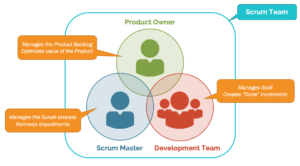According to the National Restaurant Association, over 1 million restaurants are fighting to survive during this uncertain time. By implementing strategies to help reinforce the connection between restaurants and the diner, brands can stay agile while also keeping true to their mission.
Scrum is the best approach to develop a culture of continuous experimentation and learning is by using experiments.
6 tips that can help you adapt Agile Scrum to your restaurant
1. Define your Scrum Team

There are 3 agile Scrum team roles: Product Owner, Scrum Master, and Development Team.
The main responsibility of the Product Owner is to understand the business and customer requirements, define and prioritize the work accordingly.
- Building and managing the product backlog
- Communicating with the business and team to ensure everyone is on the same page
- Guide the team on which features to deliver next
- Decide when to ship the product
The Product Owner takes on the role of the waiter since they interact with customers and understands their requirements and desires.
The Scrum Master helps the team apply the Scrum framework successfully. This role is responsible for ensuring the team follows the agreed processes. The Scrum Master also leads the Daily Scrum meetings. In this analogy, Scrum Master takes on the role of the head waiter/host, since they are always looking for ways to improve the restaurant’s processes.
The Development Team is the foundation of the Scrum team. While the product owner outlines the priorities and the Scrum master monitors the process, the development team is responsible for determining how to get the work done. The Development Team can be the kitchen staff, which creates the solution.
2. Start with Daily Scrum meetings
Many people in the restaurant world call standups “line-ups”. In the traditional scrum meeting format, the members of a team report on their progress during those meetings. Make them short – 15 min.
3. Product Backlog Refinement Meeting
Backlog Refinement is an ongoing process in which the Product Owner and the Development Team collaborate to ensure that items on the Product Backlog:
- are understood the same way by all involved (shared understanding),
- have a size estimate for the (relative) complexity and effort of their implementation, and
- are ordered according to their priority in terms of business value and effort required.
4. Sprint Planning Meeting
In the meeting, the product owner and the scrum development team will meet to discuss how they will use the requirements in the product backlog to turn it into a workable and shippable product. In this case, or they can decide on what ingredients they would need and want to include to make it work with a specific bread that is already at the top of the product backlog list.
5. Sprint Review Meeting
The sprint review is an informal meeting which the development team, the scrum master, product owner and the stakeholders will attend. The team gives a demo of the product and will determine what are finished and what aren’t. The demo can be a new menu or a review of any changes that occurred in your industry.
6. Sprint retrospective meeting
This meeting can be used to discuss relationships with other members and how they deal with conflicts.
Scrum can be adapted to any business and we are here to help you.
